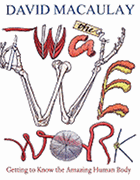

Working in colored pencils, Macaulay lightens up the proceedings with many humorous touches, such as a kickline of humans, each highlighting the body's various systems and the cells and body parts associated with it, or a couple of boys shooting paper airplanes into a highly magnified close-up of the nasal cavity on the in-breath (the woolly mammoth from The Way Things Work also gets a cameo, spleen-side). He also has a lot of fun with subtitles (e.g., "A Brief History of Chyme," the name for the partially digested food that enters the duodenum; and "Bridge of Thighs," for which the artist pictures a giant pelvis propped up by a pair of femurs against a backdrop of Venice). Most often, Macaulay's text strikes a tone of wonder ("It may be no match for a bloodhound's, but our sense of smell can distinguish between some 10,000 different odors"), reinforced by illustrations of tiny human spectators at the base of a giant skull or on a terrace overlooking the interconnected "zones" of the kidneys. For his exploration of the reproductive system, Macaulay brings that first single cell full circle. He depicts--through an illustration of solely the relevant anatomical parts--how sperm and egg join to form the first cell that, within it, contains all of the information necessary to generate 100 trillion other cells, and create an entirely unique human being. He treats his subject and his readers with equal respect.--Jennifer M. Brown

